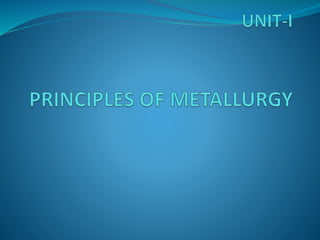
Principles of Metallurgy
- 2. Occurrence of Metals Generally, metals occur in nature as their compound (except less active metals like Cu, Ag, Au etc. which found native state). The metallic compounds that in the earth are called minerals. The minerals from which metals can be extracted readily and profitably are called ores.
- 3. Types of ores Ores are found in the form of oxides, sulphate carbonates, sulphates, chlorides and silicates. Ore Example Oxide ore Al,Fe, Ti Sulphide ores Cu, Zn, Hg Carbonate ores Mg, Zn Ca Sulhate ores Mg, Ca, Ba Chloride ores Na, Mg, Ag Silicate ores Mg, Al
- 4. Flux The earthy impurity or gangue is generally infusible. But it can be converted into a fusible mass called slag by the addition of a compound called flux. Being light. The slag floats on the molten metal and can skimmed off. Gangue + Flux --------> Slag The nature of flux used depends upon the nature of the impurity to be removed. A basic flux An acidic flux
- 5. Refining of Metal Vapour phase refining Ultra-pure metals like titanium, zirconium, vanadium, thorium etc. are obtained by this method. Electrolytic refining This is the most convement method for refining metals like copper, silver, gold, tin, chromium and nickel. By electrolytic refining 99.9 percent pure metal can be obtained. Zone refining Pure metals (with impurities < 10-9atom percent) to obtained by the zone refining technique.
- 6. EXTRACTION OF METALS TITANIUM Occurrence Titanium does not occur fee in nature. In the combined state, it occurs in sands and rocks. Its main ores are: Rutile TiO2 Ilmenite FeTiO3
- 7. Extraction Titanium metal is commercially obtained from ilmenite ore. The extraction consists of three steps: Purification of Ti (van Arkel method) Reduction of TiCl4 (kroll’s process) Preparation of TiCl4 (Chlorination process) Modern method Conversion of the ore in to TiO2 Reduction of TiO2 (Alumino-thermite process)
- 8. Uses As metal Titanium cathode is used in special photoelectric cells. Pure titanium metal is used in making incandescent titament. As alloys Alloys of Ti with Co and Ni are used in making filaments in vacuum tubes in place of Pt-Ir alloy which is very costly. Ferrotitanium, an alloy of Ti with Fe is used as scavenger in steel industry. It removes adsorbed oxygen and nitrogen.
- 9. THORIUM Occurrence Thorium is widely distributed in nature is association with uranium and rare earths (mainly La and Ce). Its chief ores are: Thorite ThO2. SiO2 Thorianite ThO2.UO2.SiO2 Monazite Th3(PO4)4. (La.Co)PO4
- 10. Extraction Preparation of Thoria Purification of Thoria Conversion of ThO2 to ThCl4 Reduction of ThCl4 Purification of Th (Van Arkel method)
- 11. Uses As metal Thorium is a redicative element. Bombardment of thorium with thermal neutrons leads to the formation of u233 isotope. Equation As alloys Thorium alloys are used as reducing agents in metallurgy.
- 12. Molybdenum OCCURRENCE Molybdenum never occurs in native state. Its chief ores are: Molybdenite MoS2 Wulfenite PbMoO4 Molybdite Fe2O3 3MoO3 7.5 H2O
- 13. EXTRACTION Concentration concentrated by froth flontation process. Roasting a current of air in a reverberatory furnace when crude MoO3 is formed. Purification of MoO3: The crude MoO3 is boiled with excess of concentrated ammonia when ammonium molybdate is formed Metallurgy: Molybdenum inetal is obtained by the reduction of pure MoO3 by hydrogen at 11000C. Refining: The metal is heated in a current of carbon monoxide at 2000C under pressure.
- 14. Uses As metal Molybdenum metal is used as an anticathode in X-ray tubes. With tungsten, it is used as thermocouple for high temperature measurements. It is used as a support for tungsten filament incandescent bulbs. As alloys Molybdenum steels are used for making rifle barrel, high speed lathe tools etc. Stainless steel containing 2-4% molybdenum is corrosion resistant and used to make surgical instruments.
- 15. COBALT Occurrence: Cobalt occurs mainly as arsenides and sulphides. The principal ores are: Smaltite (Co, Ni, Fe) As2 Cobaltite (Co, Fe, As) S
- 16. Extraction Concentration Roasting Smelting Roasting the spies with NaCl Removal of Cu and Fe Separation of Ni from Co Formation of Co3O4 Reduction of Co3O4
- 17. Uses In electroplating For making blue glasses, tiles and enamels For the manufacture of special steels. Stellites (55% Co, 15% Cr, 22% W and 5% Mo). It is used for making cutting tools, lathe tools and surgical instruments. Cochrome (60% Co, 14% Cr and 24% Fe). It is used for making resistance wires.
- 18. PLATINUM Occurrence:Platinum mostly occurs in the native state. The metal is obtained as a by-producing during the extraction of nickel by Mond’s process. The production of platinum metal from the Mond’s process residue involves two steps: Preparation of the platinum metals concentrate Separation of platinum form the concentrate.
- 19. Separation of platinum from the concentrate Treatment of concentrate with Aqua-regia: Separation of Gold: Recovery of Pt: Separation of Pd: Uses As metal Platinum metal resists corrosion and hence used in making laboratory apparatus such as erucibles, basins, boats, dishes and incinerating pans. As alloys Platinum is a silvery white noble metal. A alloy of platinum with irridium or palladium has been used in jewellery. An alloy of platinum with iridium is used in fountain pen nibs.